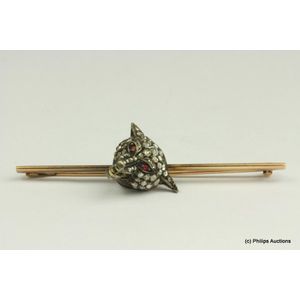Diamond Wolf Brooch in Rose Gold and Silver
You must be a subscriber, and be logged in to view price and dealer details.
Subscribe Now to view actual auction price for this item
When you subscribe, you have the option of setting the currency in which to display prices to $Au, $US, $NZ or Stg.
- Pave Setting - Pave setting is a style of setting stones in jewellery where the small stones are placed close together in holes drilled in the metal, the burr of the metal around the stone being pressed over the edges to hold the stone in position.
- Oxidised (finish in Jewellery) - An oxidised finish in jewellery, particularly gold, refers to a surface treatment that intentionally darkens or blackens the metal surface to create an antique or vintage look. The process involves using a chemical solution to speed up the natural tarnishing or corrosion of the metal, resulting in a dark, matte or semi-matte finish.
In gold jewellery, oxidised finishes are typically applied to lower karat gold alloys, such as 14k or 18k gold, rather than higher karat gold, such as 22k or 24k gold. This is because lower karat gold alloys contain more base metals, such as copper, which are more reactive and prone to tarnishing.
Oxidised finishes in gold jewellery can create a wide range of looks, from a subtle aged patina to a more dramatic blackened finish, depending on the strength and duration of the chemical treatment. This type of finish can add depth and character to jewellery designs, and is often used to create contrast between different elements or textures in a piece. - Rose Cut - A flat based cut for a preious stone, leaving the surface covered with triangular facets, usually 24 in total.
It was introduced in the 15th century and popular during the 16th and 17th centuries.
The rose cut was the most popular form of diamond cut until the discovery of the brilliant cut at the end of the 17th century, after which its use declined.
This item has been included into following indexes:
Visually similar items

9ct bar brooch mounted with butterfly of seed pearls

15ct gold bar brooch with semi-precious stone, weight: approx 2.1 grams, inscribed J Y 17-02-06

Two Russian silver sugar nips, 84 zolotnik purity (875), circa 1896-1908 and circa 1915, 72 grams approx

A delightful Squirrel bar brooch, 9ct yellow gold with a high carat wash, made as a bar square edged bar brooch supporting a naturalistically styled crouching squirrel in brushed gold finish, holding in its paws a pearl, fitted with pin
